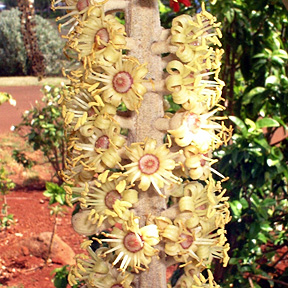
|
In the Garden
|
This plant looks as if
it’s straight out of
‘Jurassic Park’
Munroidendron racemosum
Description: Trippy is the word that came to mind when I first saw a full-grown specimen of this plant. I couldn't believe it came from Hawaii or anywhere from present-day Earth.
![]()

The Munroidendron is nearly extinct in the wild with only three small populations on Kauai.
Distribution: This is a super-duper, not-even-joking, hurry-up-and-do-something, almost-pau, no-more-nothing-left tree. It's listed as an endangered species but should be in a separate category of plants on the verge of extinction. Only three small populations are left, on the island of Kauai, so when I say it looks like it came straight out of "Jurassic Park," that's halfway true -- much of the movie was filmed on Kauai.
Cultural uses: No cultural uses are known at this time. In fact, the plant is so rare that there is no known Hawaiian name.
Landscape uses and care: If you are in search of this plant for your garden, lucky you: It's for sale at Home Depot for about $9. These plants are cultivated from what few remaining plants are left in the wild. Plant it in a place where you can show it off as it deserves. Water daily until the plant is established in the ground (until you see signs of active growth), then slowly cut back on your watering schedule. Spider mites and aphids occasionally show up on young or newly transplanted plants, but these pests can be treated with store-bought pesticides or by spraying them off with water.
Also: This endangered plant comes from the same family (Arialacea) as the highly invasive octopus tree (Schefflera actinophylla), which is taking over much of our native mesic forests. These are the same forests that this truly Hawaiian plant, along with its other native relatives, used to thrive in.
nativehawaiianplants.com
![]()
E-mail to Features Desk
[News] [Business] [Features] [Sports] [Editorial] [Do It Electric!]
[Classified Ads] [Search] [Subscribe] [Info] [Letter to Editor]
[Feedback]
